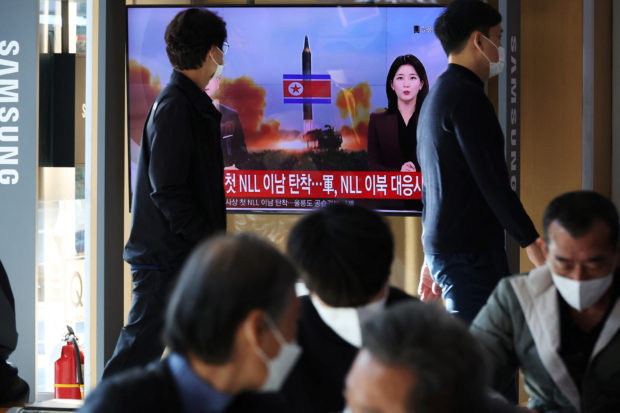EXPLAINER: North Korea is developing ICBMs. What are they?

People watch a TV broadcasting a news report on North Korea firing a ballistic missile off its east coast, in Seoul, South Korea, November 2, 2022. REUTERS/Kim Hong-Ji
SEOUL — North Korea has dramatically ramped up missile tests this year and tested intercontinental ballistic missiles or ICBMs on Thursday, November 3, as part of efforts to develop a nuclear-tipped missile that can strike the U.S. mainland.
Here are some characteristics of ICBMs, and North Korea’s ICBM arsenal.
WHAT ARE ICBMS?
ICBMs are ballistic missiles with a minimum range of about 5,500 kilometers (3,400 miles), chiefly designed for nuclear weapons delivery. Some are capable of traveling 10,000 km (6,200 miles) or farther.
Some missiles carry only one warhead, but modern ICBMs can carry multiple warheads, each able to hit a separate aim point, on independently targetable reentry vehicles (MIRVs).
READ: North Korea fires suspected ICBM, warns U.S. against ‘dangerous’ choices
ICBMs can be launched from multiple platforms. Fixed launch sites such as missile silos offer more protection but are vulnerable to preemptive strikes. Mobile launchers, including submarines, heavy trucks, and rails, are more difficult to detect and provide greater mobility but are vulnerable if caught in the open.
WHO HAS THEM?
Russia, the United States, China, Britain, France, and India have deployed ICBMs, either on land or at sea.
North Korea conducted the first successful test of its Hwasong-14 ICBM in July 2017.
HOW MANY ICBMs DOES NORTH KOREA HAVE?
Shortly after two successful tests of the Hwasong-14, North Korea launched a new ICBM, the Hwasong-15, in November 2017.
The continental United States is about 9,000 km (5,500 miles) from North Korea, and some U.S. and South Korean experts believe both missiles can fly more than 10,000 km (6,213 miles), putting many parts of the United States in range.
READ: EXPLAINER: What makes a nuclear weapon ‘tactical’?
North Korean leader Kim Jong Un declared after the Hwasong-15 test that the country had achieved the “great historic cause of completing the state nuclear force.”
In March 2022, North Korea launched its massive Hwasong-17 ICBM for the first time after unveiling it at a pre-dawn military parade in October 2020. The missile is large enough to potentially deliver a nuclear warhead anywhere in the United States.
Unlike any of North Korea’s previous ICBM tests, the Hwasong-17 was launched directly from a transporter-erector-launcher vehicle with 11 axles, which experts said is the largest road-mobile, liquid-fueled ICBM in the world.
RELATED STORY